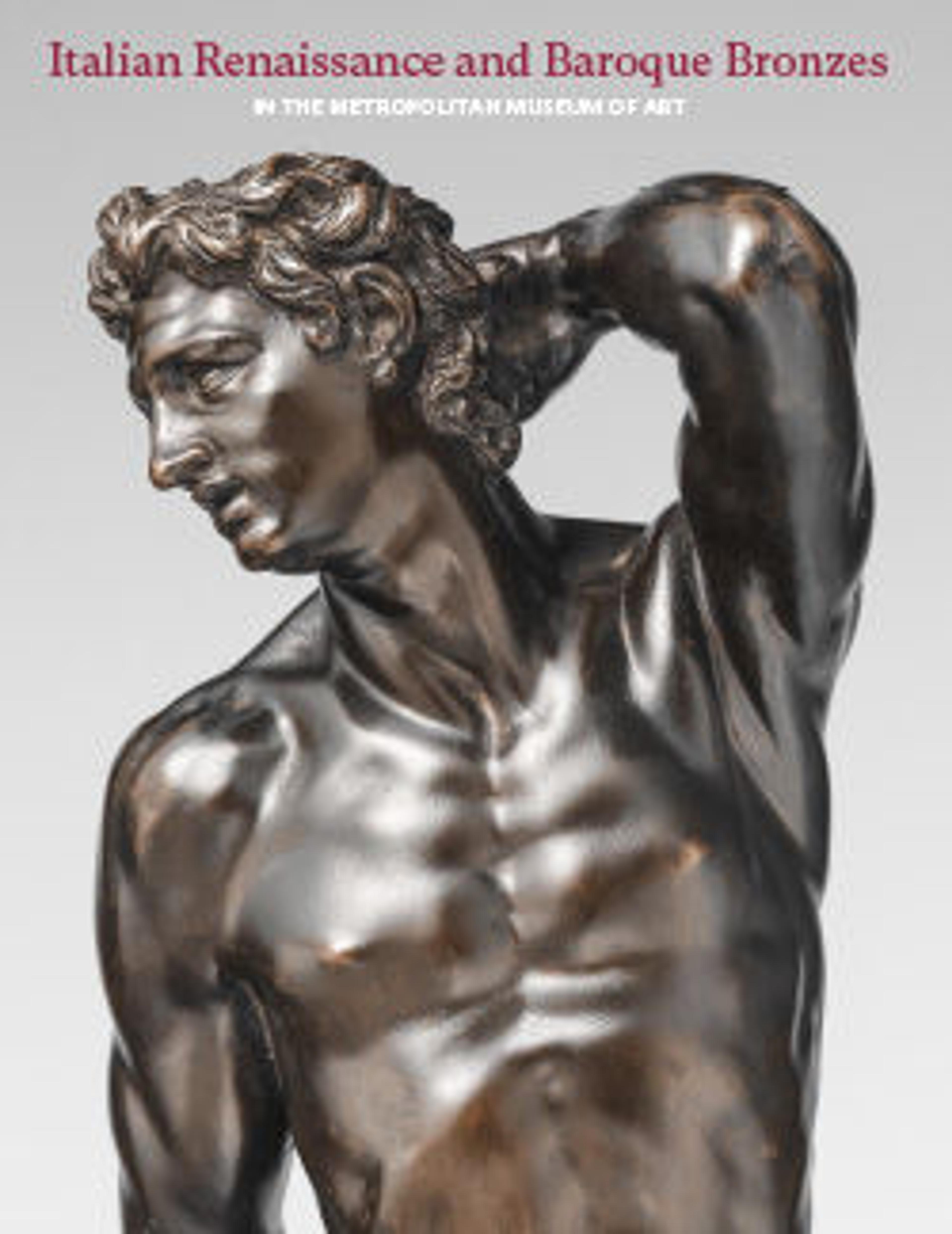Renaissance-style statuette group of Victory of Virtue over Vice
The bronze depicts a youthful nude subjugating an anthropomorphic creature with a canine face and the claws and furry long legs of a satyr. It entered The Met with an attribution to the Tuscan artist Pierino da Vinci, endorsed by Leo Planiscig, but of which Yvonne Hackenbroch was skeptical.[1] While Planiscig identified the prototype for the Untermyer group as the bronze Samson and the Philistines traditionally linked to Michelangelo (see cat. 98), Hackenbroch traced its source to another well-known sixteenth-century Florentine creation, the large marble Triumph of Virtue over Vice by the Perugian sculptor Vincenzo Danti.[2]
Our bronze does seem closer in spirit to Danti’s group in its compact composition and the oblique pose of the victor. The monstrous appearance of the defeated figure resonates as well with Valerio Cioli’s terracotta of the same subject, another nod to Danti.[3] The Untermyer and Cioli dimensions match, and the vanquished creature in both has a snakelike tail and fierce features. But neither the Pierino attribution nor the connection to Danti, or even to the Renaissance, is tenable. The bronze’s style suggests a much later time frame. Its high, earthy base and the creature’s physiognomy indicate familiarity with Rodin’s koiné, and certain technical aspects point to a very late cast as well.[4] The evident but free citation of Florentine models and the hellish appearance of the devilish creature lead to the conclusion that this work is more a d’après than a fraudulent imitation intended to be sold on the international market as a Renaissance bronze. Nonetheless, the sculpture soon acquired that identity, perhaps by way of an unscrupulous art dealer, even managing to deceive a connoisseur like Planiscig.
-TM
Footnotes
(For key to shortened references see bibliography in Allen, Italian Renaissance and Baroque Bronzes in The Metropolitan Museum of Art. NY: The Metropolitan Museum of Art, 2022.)
1. ESDA/OF; Untermyer 1962, p. 17, pl. 50.
2. Bargello, 3 S.
3. Bargello, 286 S; see Claudio Pizzorusso in Davis and Paolozzi Strozzi 2008, p. 304, cat. 3.
4. Radiographs show that this spatially complex group was cast in one piece with thin even walls and no porosity, suggesting the use of flexible molding materials more commonly used in the nineteenth and twentieth centuries. The metal is a ternary alloy of copper, zinc, and tin, with very low levels of lead and no arsenic, antimony, or silver. R. Stone/TR, September 23, 2011.
Our bronze does seem closer in spirit to Danti’s group in its compact composition and the oblique pose of the victor. The monstrous appearance of the defeated figure resonates as well with Valerio Cioli’s terracotta of the same subject, another nod to Danti.[3] The Untermyer and Cioli dimensions match, and the vanquished creature in both has a snakelike tail and fierce features. But neither the Pierino attribution nor the connection to Danti, or even to the Renaissance, is tenable. The bronze’s style suggests a much later time frame. Its high, earthy base and the creature’s physiognomy indicate familiarity with Rodin’s koiné, and certain technical aspects point to a very late cast as well.[4] The evident but free citation of Florentine models and the hellish appearance of the devilish creature lead to the conclusion that this work is more a d’après than a fraudulent imitation intended to be sold on the international market as a Renaissance bronze. Nonetheless, the sculpture soon acquired that identity, perhaps by way of an unscrupulous art dealer, even managing to deceive a connoisseur like Planiscig.
-TM
Footnotes
(For key to shortened references see bibliography in Allen, Italian Renaissance and Baroque Bronzes in The Metropolitan Museum of Art. NY: The Metropolitan Museum of Art, 2022.)
1. ESDA/OF; Untermyer 1962, p. 17, pl. 50.
2. Bargello, 3 S.
3. Bargello, 286 S; see Claudio Pizzorusso in Davis and Paolozzi Strozzi 2008, p. 304, cat. 3.
4. Radiographs show that this spatially complex group was cast in one piece with thin even walls and no porosity, suggesting the use of flexible molding materials more commonly used in the nineteenth and twentieth centuries. The metal is a ternary alloy of copper, zinc, and tin, with very low levels of lead and no arsenic, antimony, or silver. R. Stone/TR, September 23, 2011.
Artwork Details
- Title:Renaissance-style statuette group of Victory of Virtue over Vice
- Date:19th or early 20th century
- Culture:possibly Italian
- Medium:Bronze
- Dimensions:Height: 18 1/8 in. (46 cm)
- Classification:Sculpture-Bronze
- Credit Line:Gift of Irwin Untermyer, 1964
- Object Number:64.101.1445
- Curatorial Department: European Sculpture and Decorative Arts
More Artwork
Research Resources
The Met provides unparalleled resources for research and welcomes an international community of students and scholars. The Met's Open Access API is where creators and researchers can connect to the The Met collection. Open Access data and public domain images are available for unrestricted commercial and noncommercial use without permission or fee.
To request images under copyright and other restrictions, please use this Image Request form.
Feedback
We continue to research and examine historical and cultural context for objects in The Met collection. If you have comments or questions about this object record, please contact us using the form below. The Museum looks forward to receiving your comments.
